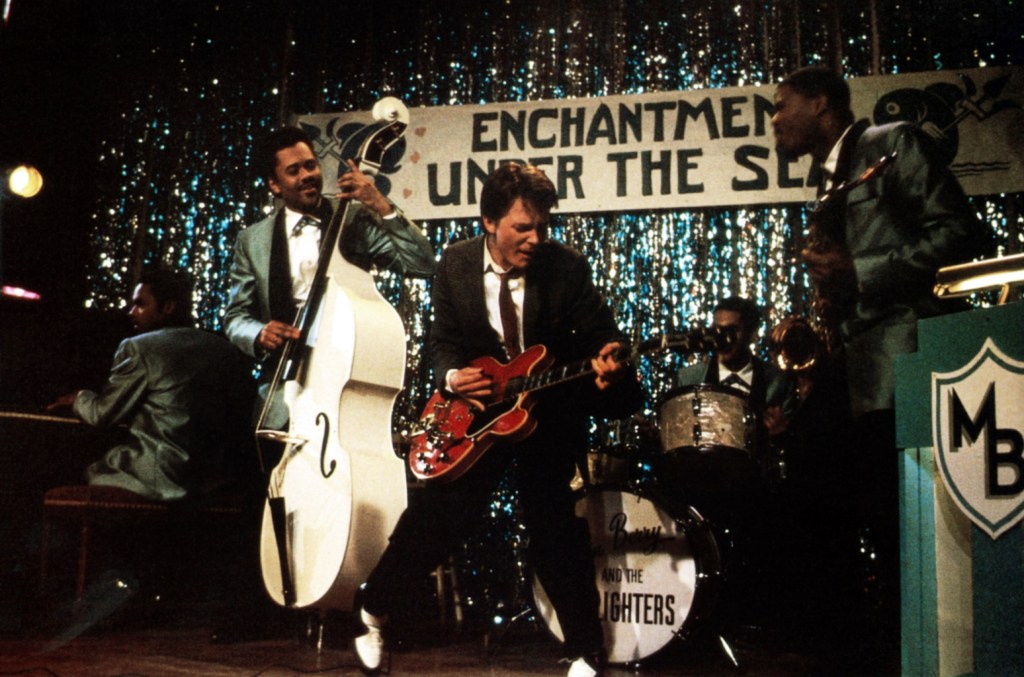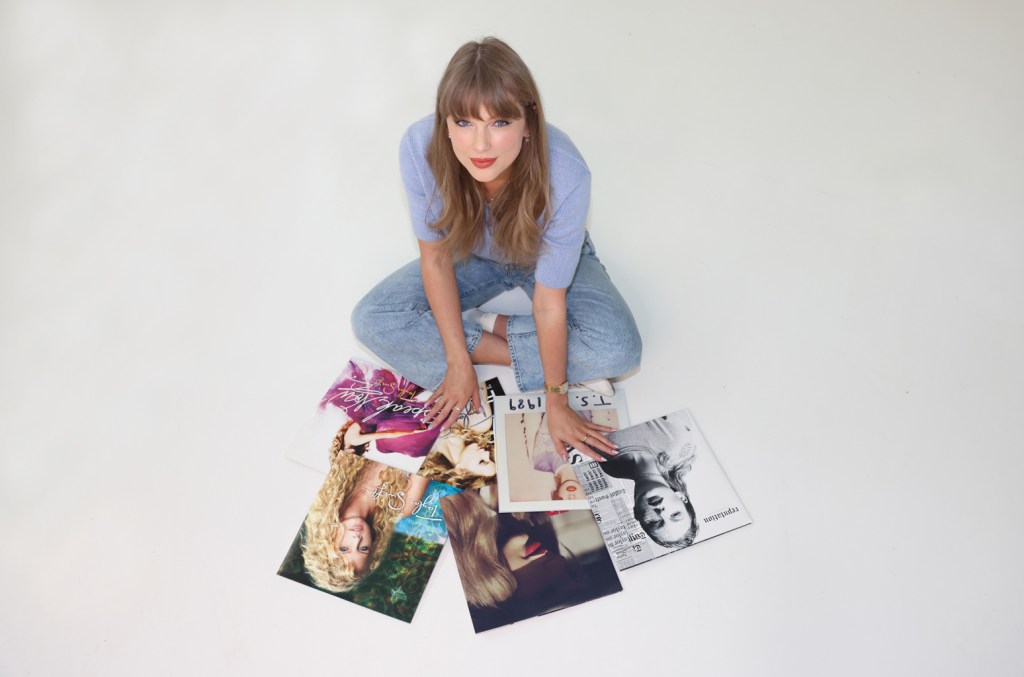The Guitar Michael J. Fox Played In ‘Back to the Future’ Is Missing — And They’re Making A Movie About the Search For It
Written by djfrosty on June 3, 2025

The hunt is on for an iconic but missing artifact from Robert Zemeckis’ classic 1985 film Back to the Future.
Gibson Guitars and Universal Home Entertainment, in conjunction with filmmaker Doc Crotzer, have launched Lost to the Future, a search for the Gibson ES-345 Cherry Red guitar that Michael J. Fox, as Marty McFly, played in the beloved film. As fans well know, Fox picked up the guitar during the movie’s Enchantment Under the Sea high school dance, where he performed the Penguins’ “Earth Angel” and then shredded Chuck Berry’s “Johnny B. Goode.”
The guitar, which was rented as a prop from Norm’s Rare Guitars in Tarzana, Calif., has been missing for several decades. Now Gibson and Crotzer (Road House, Shotgun Wedding, Glee) have begun a “true crime search” for the instrument, and the filmmaker is planning to make a documentary about the endeavor.
“Back to the Future made me want to make movies as a kid, and made me want to pick up a guitar,” Crotzer tells Billboard. “I’m a guitar player but I’m just a hobbyist; I went on with my (filmmaking) career, but I had always wondered what happened to that guitar. Over the last however many years so many props from the movie have surfaced…but (the guitar) had never surfaced.”
Trending on Billboard
Gibson’s director of brand experience Mark Agnesi, who previously worked at Norm’s Rare Guitars before joining Gibson, also cites the “Johnny B. Goode” scene as one of his inspirations to play. “I’ve been searching for this thing for 16 years now,” he says. “I started searching everywhere. Norm’s has this big warehouse of guitars and occasionally I’d go in and look for certain things, and every time I’m in there I was always looking around for (the Back to the Future guitar), but to no avail.”
They aren’t the only ones who were inspired by the scene, of course. When Fox joined Coldplay at last year’s Glastonbury Festival in England, frontman Chris Martin told the crowd that, “The main reason why we’re in a band is because of watching Back to the Future,” adding that Fox is “our hero forever and one of the most amazing people on Earth.” In a new video announcing the Lost to the Future project, John Mayer notes that the scene “was a big Rocky moment for a lot of kids,” while Jason Isbell explains “that’s the most iconic guitar from a movie. I don’t think anything else comes close…That was a huge deal for me. The world needs to see that guitar.”
Those with leads about the guitar’s whereabouts are asked to call 1-888-345-1955 or send a message via www.LostToTheFuture.com.
The trail for the guitar is indeed cold. It was apparently sold, then sold back to Norm’s and then presumably resold again. “Back then there was no digital record of that stuff; it was all hand-written receipts and stuff,” Gibson’s Agnesi says. “We know it was returned to Norm’s. At that time in the mid ‘80s there was a Japanese vintage guitar boom; charter buses of Japanese tourists were pulling up and buying everything in sight. So it could be someone has it in Japan. We don’t know. The possibilities of where it could be are endless.”
The guitar’s serial number is not known, but there is a unique tell that will allow it to be authenticated, according to Agnesi; the inlay on its 12th fret is solid, not split like the others on the neck, which was standard for the ES-345 at the time. “That anomaly is the smoking gun we’re looking for, thank God,” Agnesi says. “That will not be on any other guitar. Either someone custom-ordered it that way or it would be marked a factory second on the back of the head stock. That’s how we’ll know we’ve found the guitar we’re looking for.”
Filmmaker Crotzer adds that the tell is “the most amazing coincidence. I personally believe it’s like some higher power giving us the opportunity to find the thing.”
An irony is that while Back to the Future is set in 1955, the ES-345 was not yet in production in 1958, and not made in cherry red until the following year. “Norm has publicly said he knew that guitar was wrong for the era,” Agnesi notes, adding that in ’55 Berry was playing a Gibson ES-5 Switchmaster. But the filmmakers, he says, wanted something slimmer and more streamlined. “They wanted that Chuck Berry 345 look even though it wasn’t the right guitar for the time period,” Agnesi says. “They were willing to take some small liberties and have fun in the movie with it. If not for that guitar, the scene might not have been as impactful.”
It also dovetails with the fact that “Johnny B. Goode” wasn’t released until 1958 — adding to Marty McFly’s future prognostication that, “I guess you guys aren’t ready for that yet, but your kids are gonna love it.”
Charles Berry says that his father was not bothered by those historical inaccuracies, however. “Dad was fairly laid back when it came to stuff like that,” he says, adding that the family didn’t know about the “Johnny B. Goode” scene “until maybe a month or two before. It’s just like (the 1987 documentary) Hail! Hail! Rock ‘n’ Roll; he said, ‘Oh yeah, by the way, they want to make this movie about me.’ (Back to the Future) was the same type of thing; he comes to the house and says, ‘Yeah, there’s this movie coming out, in one of the scenes this kid’s playing ‘Johnny B. Goode.’ ‘Really?!”
Seeing the film, the younger Berry — who owns some of his father’s old guitars and administrates the loan or donation of others to museums — says, “We got a kick out of it. It’s a very good movie, a nice wholesome movie. Michael J. Fox did a really cool job. It may not be exactly the right guitar, but we’ll take it.”
The scene famously ends with one of the band members, ostensibly Berry’s cousin Marvin, calling the rock n’ roll pioneer and holding the phone up to hear what’s being played on stage. “Besides, ‘What’s it like to be Chuck Berry’s son?,’ after ’85 the most-asked question I get is, ‘Does your dad really have a cousin Marvin?’” says Charles Berry with a laugh. “No, it was just in the movie.”
The video announcing the search also features Back to the Future co-screenwriter Bob Gale, co-stars Lea Thompson and Christopher Lloyd, and Huey Lewis, who had an uncredited bit part and, with his band the News, scored a Billboard Hot 100 No. 1 hit with “The Power of Love” from the soundtrack. “Back to the Future, it keeps growing; it’s like a Wizard of Oz for a new generation,” says Lewis, adding that, “it’s fascinating (the guitar) has not turned up. It’s a very distinctive one. Whoever has this guitar must not have heard that they’re searching for it yet. Once the word is out, if you’ve got a 345, you’re going to look and see if that’s the one.”
The search is part of a number of Gibson initiatives related to the film and the guitar’s legacy in it. An episode of Gibson TV: The Collection that premieres in October features Fox talking about his own history of guitar playing and his collection of 40-some instruments. The same month, Gibson and Epiphone will release new custom models of the ES-345 as well as Back to the Future-themed apparel, and Gibson Gives will announce a partnership with the Michael J. Fox Foundation.
“I just wanted to be a rock n’ roll guitarist,” Fox says in The Collection. “That’s all I wanted to do. I became an actor instead of a guitarist…It’s always been a passion of mine, rock n’ roll — especially the guitar.” He adds that the ES-345 in the film “was such a good guitar. It’s like Excalibur…. Being 23 years old and that scene, I was having the f–king best time. But I didn’t realize the influence it had on people. It’s just expressing my love for the guitar and all the great players.”
Crotzer says all of that will be part of the Lost to the Future documentary. A happy ending is hoped for, but Crotzer is also out to tell the greater story surrounding it.
“We’ve realized (the story) is bigger than we thought,” he says. “The through-line is the true crime search for this guitar, but the emotional core of it is tracking how it inspired a generation of kids, whether they went on to become Chris Martin or went off to do completely other things. There’s a collective experience here that we really want to capture.”

 State Champ Radio
State Champ Radio 





